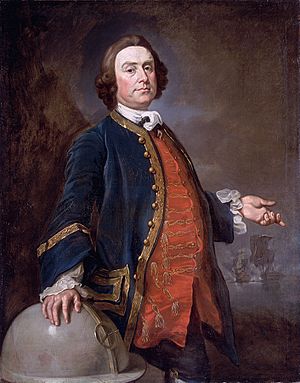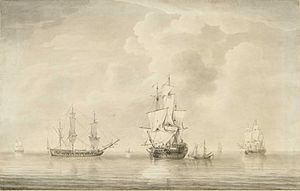George Walker (privateer) facts for kids
George Walker (died 1777) was a brave English privateer. He was known for sailing ships that attacked French trading vessels during wartime. Privateers were like legal pirates, allowed by their government to capture enemy ships and their valuable cargo.
Contents
Early Life and First Adventures
When George Walker was young, he served in the Dutch navy. He helped protect trading ships in the Mediterranean Sea from pirates. Later, he became the owner and captain of his own merchant ship.
In 1739, Walker was the main owner and captain of a ship called the Duke William. This ship traded between London and South Carolina. To protect his ship, he got special permission called "letters of marque." This allowed him to attack enemy ships if needed.
The Duke William had 20 cannons but only 32 men. The coast of the Carolinas was full of Spanish privateers. Since there were no English warships nearby, Walker offered his ship to the local government. They accepted, and he added more men, bringing his crew to 130. He successfully chased away the Spanish ships.
In late 1742, he sailed for England with three other merchant ships. But a big storm hit as they neared the English Channel. His ship, the Duke William, started to leak badly. Walker and his crew quickly moved to one of the other merchant ships, which barely stayed afloat.
When Walker finally reached England, he found out his insurance had run out. He had lost everything. For the next year, he worked as a captain on a ship trading in the Baltic Sea.
Becoming a Famous Privateer
In 1744, war started with France as part of the War of the Austrian Succession. Walker was offered command of a private warship called the Mars. It had 26 cannons and would sail with another larger ship, the Boscawen. Both ships belonged to the same owner.
They left Dartmouth in November. In January 1745, they met two French warships. The Boscawen quickly ran away, leaving the Mars to be captured. Walker became a prisoner on the French ship Fleuron. A few days later, an English squadron saw the French ships but did not attack. Walker was treated well and soon exchanged, returning to England.
Back in England, Walker was given command of the Boscawen. The Mars had been recaptured and bought back by its old owners. The two ships sailed together but didn't have much success that year. In December 1745, the Boscawen, which was not built very strongly, almost broke apart. Walker managed to get it safely to shore at St Ives in Cornwall.
Soon after, he was offered a much bigger command. This was a group of four ships known as the "Royal Family." These ships were the King George, Prince Frederick, Duke, and Princess Amelia. Together, they had 121 cannons and 970 men. In 1745, off Louisbourg, Nova Scotia, this group had captured a very valuable prize. Because of this, they had many skilled sailors.
After sailing for a year and capturing prizes worth over £200,000, the Royal Family ships went to Lisbon. In July 1747, they were getting fresh water in Lagos Bay. On October 6, they saw a large ship near Cape St. Vincent. This was the Spanish ship Glorioso, which had 70 cannons and was thought to be carrying treasure. However, the treasure had already been unloaded.
Walker believed it still had treasure and attacked it in his ship, the King George, which had 32 cannons. The King George was almost defeated. But when the Prince Frederick arrived, the Glorioso sailed away. It was then met by HMS Dartmouth, an English warship with 50 cannons. The Dartmouth exploded during the fight, and most of its crew were lost. Hours later, the 80-cannon ship HMS Russell fought the Glorioso and captured it. The Russell needed help from Walker's privateers to take the captured ship to the River Tagus.
The Royal Family continued to capture ships until the war ended with the Treaty of Aix-la-Chapelle (1748). In total, the prizes taken by the Royal Family under Walker's command were worth about £400,000.
Helping the Fishing Industry
When the war ended, Walker returned to England. He believed he had earned a good amount of money from his privateering. He became very interested in helping the British fishing industry grow again. He invested most of his money into this cause before he even received his share from the Royal Family's earnings.
Walker did important work to help the fishing of herring, cod, and ling. In 1749, he sailed to the Orkney and Zetland Islands in Scotland. He was with other gentlemen who wanted to find good places to set up fishing businesses. He explored the islands, checked the harbors, and gathered a lot of information about fishing and other local industries.
People at the time praised his efforts. One writing said that Captain Walker, after bravely fighting enemies, was now using his earnings to improve his own country. He was even thinking about leasing the Isle of Arran to develop it for fishing.
In 1750, a special group called the Society of the Free British Fishery was formed. The Prince of Wales was its leader, and many important people were on its council. However, the project did not succeed. Walker himself said that "Party contending for a majority in it, and Inexperience presiding at the board." This meant that political arguments and a lack of experience among the leaders caused problems.
Even though a lot of money was raised, and the Society had many fishing vessels, they faced difficulties. Some of their ships were captured by French privateers. By 1772, the remaining ships and goods were sold for a much smaller amount.
Financial Troubles and Later Life
After the Royal Family ships returned with their captured goods, many sailors were forced into the navy. They never received their share of the prize money. Instead, the money was put into a bank and became stuck in a long legal process.
In 1749, some sailors tried to get their money through the courts. In 1752, a judge ruled in their favor. However, the ship owners delayed the process, and the sailors, who didn't have much money, couldn't keep fighting for their claims. The legal battles lasted until 1810, when the case was finally dropped.
While the common sailors faced problems, Commodore Walker also suffered. He was great at leading ships and fighting, but not good with money matters. In 1756, he was arrested for a debt of £800. He was put in King's Bench Prison for four years. The first year was in a small, harsh cell, which hurt his health. In 1757, he was declared bankrupt.
After prison, Walker commanded a ship in the fishing trade. He had a good friend named Hugh Baillie who helped him. In 1763, Walker went to Nova Scotia to start a new business life. Together, he and Baillie opened a fishery at Alston Point on the Nepisiguit River around 1766 or 1768. Over the next ten years, they made a lot of money from fish and fur. Walker is believed to be the first English settler in that area.
After building warehouses and fishing stages, Walker returned to England. He found out that the land he had improved had been given to someone else. He and Baillie bought the land for £600. By 1769, he seemed to be a local judge at Alston Point. In 1773, Baillie sold his rights to John Schoolbred. The settlement continued to grow. By 1775, Walker was in charge of a busy place with twenty British workers. They were fishing, trading, building ships, cutting timber, and even farming.
Then, in 1776, American privateers destroyed the settlement at Alston Point. Walker returned to England after this. He was given a smaller command under an admiral in North America. It is said he died suddenly just as his new expedition was about to sail.
The Town and Country Magazine reported his death in October 1777. He was buried on September 24, 1777, at the church of All Hallows in Barking-by-the-Tower.
We don't know much about his parents, birth, or childhood. But George Walker is remembered as one of the greatest English privateer captains. He was a humble, honest, and incredibly brave man. He was excellent at his duties, though not always good with his own money.
Around 1750, the artist Charles Brooking painted "Commodore Walker's Action: the Privateer 'Boscawen' Engaging a Fleet of French Ships, 23 May 1745."



